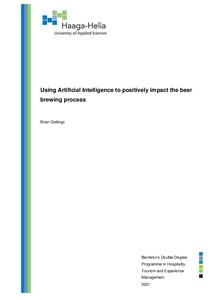Using Artificial Intelligence to positively impact the beer brewing process
Geilings, Brian (2021)
Geilings, Brian
2021
All rights reserved. This publication is copyrighted. You may download, display and print it for Your own personal use. Commercial use is prohibited.
Julkaisun pysyvä osoite on
https://urn.fi/URN:NBN:fi:amk-2021052812124
https://urn.fi/URN:NBN:fi:amk-2021052812124
Tiivistelmä
The beer brewing industry has always been a creative and innovative one, with new beers being introduced to the market each year. Even though the COVID-19 pandemic crisis has truly tested the hospitality industry e.g. in terms of how bars, cafés, and nightlife properties can remain open, the beer brewing industry has found ways to endure and, in some cases, even flourish. However, to continue remaining competitive in the future, new ways of conducting business are required. In particular, as Artificial Intelligence (AI) is becoming increasingly popular and integrated into both our personal and business lives, its beneficial aspects can no longer be overlooked. This product-type thesis will dis cuss the beer brewing process in detail, including the planning, improvement aspects, trends, and the Finnish beer market, and contrast these discussions with how AI can be used to positively impact the beer brewing process now and in the future.
In essence, the research presented here aims to bridge the gap between the beer industry and AI technology. The scope of this thesis will be limited to the Finnish beer market, and the end product of the thesis will be a strategic roadmap intended to help and inspire the beer brewing sector to integrate AI into their operations. Specifically, the strategic roadmap will explore three types of breweries, from early-stage breweries to micro-breweries and finally, medium-sized breweries, as it is recognized that both requirements and available resources will significantly vary depending on the type of brewery.
Insights have been generated by analyzing relevant literature, including reading books, academic articles, scientific blogs, and industry expert reports. Overall, the research has been approached by adopting a qualitative approach. Primary data was collected by conducting six semi-structured inter views between March and May 2021. Five interviews were conducted with representatives of five different beer brewing companies. The aim of these was to highlight and further elaborate on key challenges and friction points different types of breweries face. These were compiled, and in the sixth interview, presented to an AI expert who evaluated how AI technology could best be applied to ad dress issues raised by the breweries. By analyzing the data carefully and referring to the theoretical knowledge the author had the capability of methodically assembling the Strategic Roadmap. The solutions that will be presented are based upon real-life problems faced by the different breweries in their respective market. The findings help beer breweries identify opportunities for leveraging AI to positively impact their business operations.
In essence, the research presented here aims to bridge the gap between the beer industry and AI technology. The scope of this thesis will be limited to the Finnish beer market, and the end product of the thesis will be a strategic roadmap intended to help and inspire the beer brewing sector to integrate AI into their operations. Specifically, the strategic roadmap will explore three types of breweries, from early-stage breweries to micro-breweries and finally, medium-sized breweries, as it is recognized that both requirements and available resources will significantly vary depending on the type of brewery.
Insights have been generated by analyzing relevant literature, including reading books, academic articles, scientific blogs, and industry expert reports. Overall, the research has been approached by adopting a qualitative approach. Primary data was collected by conducting six semi-structured inter views between March and May 2021. Five interviews were conducted with representatives of five different beer brewing companies. The aim of these was to highlight and further elaborate on key challenges and friction points different types of breweries face. These were compiled, and in the sixth interview, presented to an AI expert who evaluated how AI technology could best be applied to ad dress issues raised by the breweries. By analyzing the data carefully and referring to the theoretical knowledge the author had the capability of methodically assembling the Strategic Roadmap. The solutions that will be presented are based upon real-life problems faced by the different breweries in their respective market. The findings help beer breweries identify opportunities for leveraging AI to positively impact their business operations.
